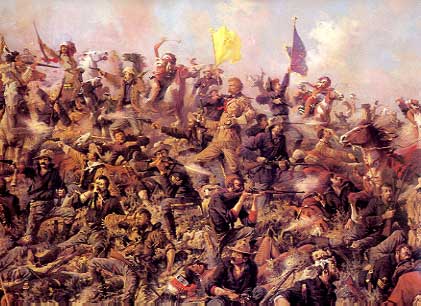

|
Custer's Last Stand Battle of the Little Big
Horn  |
|
In May of 1876 three columns of US Armed
Forces, under the commands of Generals Terry, Crook and Colonel Gibbon, rode
out to converge in southeastern Montana Territory with an aim to find
free-roaming bands (termed "hostiles") of mostly Sioux and Northern
Cheyenne tribes, round them up and force them onto the Great Sioux
Reservation in Dakota Territory. Part of that force was the US 7th Cavalry
under command of Lt. Col. George Armstrong Custer; the only unit to actually
find and confront the entire congregation of those free-roaming bands. Relying on reports of scouts, General Terry
ordered Custer to pursue the hostiles. Custer lead the 7th Cavalry out of
Gen. Terry's camp on June 22 and rode south. At dawn on June 25th, from a point called
Crow's Nest, scouts spied a gathering of Indians in a distant valley to the
west. Fearing that they would escape, Custer immediately rode toward the
Indians. With him were 586 troopers in 12 companies, 31 officers, 33 Indian
scouts, some 20 civilians, and a mule train carrying supplies and ammunition. The hostiles, under the political and spiritual
leadership of Chief Sitting Bull, were found camped in a valley by Little
Bighorn River. With them were many great warriors including Crazy Horse and
Lame White Man. In the ensuing battle Custer, a hero of the Civil War, and
210 men with him lost their lives. Although many warriors gave accounts of what
happened, Custer's last battle remained shrouded in mystery, legend, and fictional
fabrications until recent archaeological fieldwork revealed enough evidence
to corroborate historical accounts and allowed archaeologist Dr. Richard Fox
to make a detailed construct of the events of that battle. The full story of
the archaeological work and the new construct of battle events can be found
in his book Archaeology, History, and Custer's Last Battle,
(University of Oklahoma Press) In May of 1876 three
columns of US Armed Forces, under the commands of General Terry, Colonel
Gibbon, and General Crook, rode out to converge in southeastern Montana
Territory with an aim to find free-roaming bands (termed
"hostiles") of mostly Sioux and Northern Cheyenne tribes, round
them up and force them onto the Great Sioux Reservation in Dakota Territory.
The US 7th Cavalry under command of Lt. Col. George Armstrong Custer was in
General Terry's column General Terry
and Colonel Gibbon's columns linked up by Yellowstone River on June 17, 1876.
Scouts' reports of the hostiles' location pointed to the south. Ordered to pursue the
"hostiles" Custer advanced from the camp of Terry and Gibbon on
June 22. At dawn on June 25th, from a point called Crow's Nest Custer's
scouts spied a gathering of Indians in a distant valley to the west. Fearing
they would escape, Custer immediately rode toward the Indians. With him were
586 troopers in 12 companies, 31 officers, 33 Indian scouts, some 20
civilians, and a mule train carrying supplies and ammunition. Shortly, Custer
divided his command into three battalions and sent one battalion under Major
Benteen to the left. Farther up, he ordered the second battalion, under Major
Reno, to cross Little Bighorn River and attack the hostiles. Custer, with the
third Battalion veered right onto the hills by the river. Terry and
Gibbon arrived on June 27, but Custer and many men had lost their lives and
the hostiles were gone Major Reno MaMajor Reno crossed Little
Bighorn River with his battalion and charged the encampment in the
valley. (After the battle some of these men reported having seen Custer up in
the hills during their charge in the valley. That was the last reported
sighting of Custer and his men by members of the 7th Cavalry.)
Chronology: 1862 - Montana gold rush 1874 - Custer's Black Hills expedition 1874 - Gold found in the Black Hills 1876 - Custer's last battle 1877 - Sitting Bull goes to Canada 1877 - Crazy Horse killed at Fort Robinson, NE 1890 - Sitting Bull killed during arrest |
